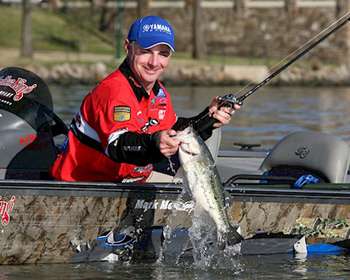
During the 2009 Elite Series campaign, a variety of baits and techniques where used to secure victories. However, in many of those wins, the lure that put an angler in position to win faltered in the home stretch and had to be replaced by an alternate bait on the final day of competition.
At Guntersville, Ala., for example, Aaron Martens switched from a crankbait to a drop shot to catch several key fish on the final day. At Kentucky Lake, Bobby Lane put down the swimbait in favor of a 10-inch Berkley Power Worm and a crankbait on the final day.
At Oneida Lake, Chad Griffin favored a topwater over a heavy jig as the tournament wore on. In his first Elite Series win on Arkansas' Lake Dardanelle, Kentucky pro Mark Menendez primarily relied on flipping soft plastics toward tight shoreline cover to secure the victory.
He points out that he was able to make the adjustment between flipping tube baits and creature baits based on what the fish were telling him — a clue that many weekend anglers might have overlooked. "I found my fish at Dardanelle with a creature bait as the water temperatures were warming up," he says. "As the tournament progressed, we had a major cold front come through and temperatures fell 14 degrees in the area I was fishing.
As a result, I made the switch to a tube bait." Menendez' years of experience lead him to make the switch. "If you're fishing before a cold front, everything is warming up and the fish are more active. In that situation, I want to flip something that puts out more vibration," he explains. Conversely, if he's fishing on the backside of a cold front — such as at the Dardanelle event — he wants something a little more subtle. "Once the front comes through and you have high, bluebird skies, it's not as critical for fish to be able to 'feel' the bait," he says.
"During these conditions you want a bait that you can stick in front of a bass' nose." Menendez uses an analogy to describe the way bass behave after a front. "It's like when you're full and you don't want to eat anymore," he says. "But if you give me a bite-sized Snickers bar after I've eaten a sandwich, I'm all over it. "The fish are not going to be out there, running the banks and looking for a big meal," he says.
"My little tube is like the candy bar to a bass in postfrontal conditions." When transitioning to a tube bait from a creature bait, Menendez points out that the action an angler gives the bait can be a key difference maker. "When you're flipping a big creature bait, you want all those appendages moving around making a lot of action in the water," he says. "When I pick up the tube after a cold front, I try to keep it in place rather than hopping it back to the boat. I'll also shake the bait a lot more."
To enhance his tube bait presentation, Menendez will add rattles to the bait. "I'm not hopping it around, but while it's moving up and down I want it to be clicking — much like you'd expect a crawfish to be doing," he says. "You want to keep the bait as close to the cover as possible. You have to realize that the bass are going to be up tight to the cover."
During postfrontal conditions, when the move from a creature bait to a tube bait has been made, Menendez reveals that color selection isn't always going to be consistent with that of his creature bait the day before. "More than anything else, water color will dictate the color of my tube," he says.
(Provided by Z3 Media)




